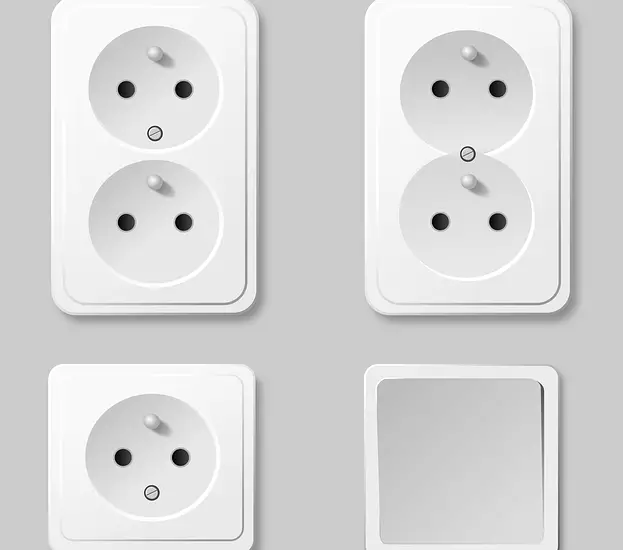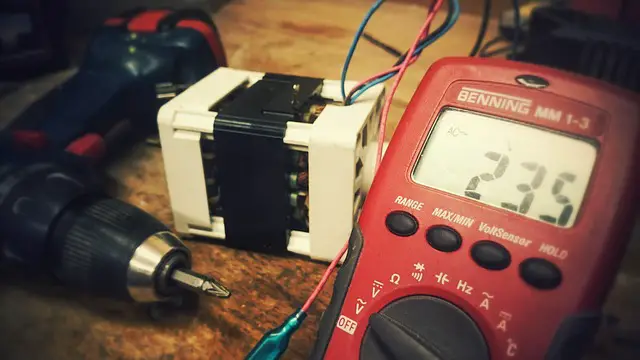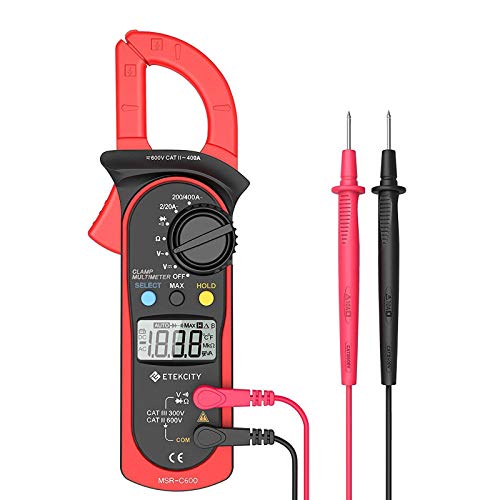
Depending on the size of your home and kitchen, you may decide to get a mini or large-sized refrigerator. From their categories, you can tell that compact refrigerators would take less energy than the large refrigerators. Nonetheless, you still need to be able to answer the question ‘how many amps does a refrigerator use.’
Meanwhile, some refrigerators are energy star certified while some are not. The certified ones also consume less energy than non-certified refrigerators.
More so, a compressor-based fridge is also more likely to draw more energy than a thermoelectric fridge of the same size.
Irrespective of the fridge you eventually decide to place in your kitchen, knowing how many amps it uses is useful.
And we will show you how to do just that in the next section.
Table of Contents
How Many Amps Does a Refrigerator Use? – How to calculate amperage
To measure the current draw (amperage) of your refrigerator without much difficulty, you would need a clamp meter.
The following steps will guide you on how to determine how many amps your refrigerator uses.
- Find out how much power the compressor draws
This is pretty straightforward.
All you need to do is to locate the compressor in your fridge. It is usually located at the bottom rear of the unit.
The compressor should have an identification tag on it with information on how much power it draws. The value is usually in watts.
According to the United States Department of Energy, a normal refrigerator uses 725 watts, but sometimes it differs due to several factors such as size and function.
Isaac from Aussie Batteries has expert information and advice on how many amps you can expect your fridge or freezer to consume in the video below. Check it out.
2. Calculate
No, you don’t need to have aced high school algebra to figure this out.
The first thing you want to note is that the voltage of your power supply at home is 120 volts.
So, to get the current in amperes, divide the value you got from your findings in Step 2 above by 120V.
For instance, if your compressor draws 725 watts, going by this calculation step, your refrigerator will draw 6 amps.
3. Use a Clamp Meter
You need a break-our cord and a clamp meter for this.
The essence of the clamp meter and the break-out cord is to measure the current as an alternative to Step 3.
So, the first thing to do is to unplug your refrigerator cord from the AC outlet and then plug it into the break-out cord. Then, plug the break-out cord into the receptacle.
Now, adjust the sensitivity of the clamp meter to the highest level (40 amps). Then, clamp the jaws of the meter around the break-out cord’s black wire.
Finally, as soon as the refrigerator cycles on, the clamp meter will display a reading. The reading it displays is the value of how many amps your refrigerator uses.
[amalinkspro type=”cta-btn-css” ctabtn-id=”” asin=”B00NWGZ4XC” apilink=”https://www.amazon.com/dp/B00NWGZ4XC?tag=refrigeratorsreviewed-20&linkCode=osi&th=1&psc=1″ addtocart=”false” new-window=”true” nofollow=”true” alignment=”alignnone”]Click here to check out this Auto-Ranging Clamp Meter and Multimeter on Amazon[/amalinkspro]
Should You Use a Separate Circuit for your Refrigerator?
Today, electrical appliances have saved us a lot of stress in the kitchen. You can just sit down and wait a while for everything to get done. Sadly, not everyone using these appliances today lives in modern buildings.
When lots of electrical appliances are used in this kind of place, it may cause the circuit breaker to trip.
Setting up a separate circuit for your refrigerator helps you avoid going to flip the plug every time it trips off, especially if you live in an old house.
Here are different reasons why setting up a separate circuit is important:
- Food safety
This usually comes into play when you’re away from home for a long time. In situations where the power goes off due to an electric overload; especially when you forget to turn off all appliances before leaving, you won’t be able to restore the power manually while you are away.
For a few days, your edibles may stay fresh. But for longer periods, your refrigerator would get warm and the items in it will go bad before you return.
A separate circuit in such a scenario will produce a more pleasant outcome.
- Power consumption
The power drawn by most refrigerators is usually between 500 and 700 watts. Dividing the number of watts by the number of volts will give you the number of amps your refrigerator consumes.
At 110 volts, a 750-watt refrigerator needs about 6.8 amps for it to function.
If you’re using a standard 15-amp circuit in your home, the refrigerator is using almost half of the current. Getting a separate circuit for your refrigerator allows you to use more appliances as discussed below.
- Using Other Appliances
If you’re using the 750-watt refrigerator, you would most likely be able to use small appliances like can openers. If you try to plug in a microwave oven or other large kitchen appliances, your circuit will trip off.
Curious about how many amps other appliances in your home consume? The video below provides information about how to calculate amps drawn by an appliance. Check it out.
Check out these other in-depth articles/reviews…
- How Long Does It Take to Defrost a Refrigerator Freezer?
- Tibek 12V Mini Fridge/Warmer with Automatic Locking Handle — In-Depth Review
- How To Change The Water Filter In A Kenmore Refrigerator
- Haier 150-Can Beverage Center — In-depth Review
- Costway 62-Can Beverage Refrigerator — Extensive Review
- How to Change Your Frigidaire Refrigerator Water Filter
How Many Amps Does A Refrigerator Use? — A Quick Recap
Here’s the answer to your question ‘how many amps does a refrigerator use?’.
The power drawn by most refrigerators is usually between 500 and 750 volts depending on several other factors.
The easiest way to calculate how many amps your refrigerator uses is by dividing the power value by the voltage. But when you use the power indicated on the compressor to derive the current it draws, you may not arrive at the right answer because the value on the compressor may not be accurate.
However, the clamp meter provides a more accurate answer.
Meanwhile, if you’re worried that your refrigerator is drawing too much current and that your circuit breaker trips off frequently, then you may want to consider getting a separate circuit for your refrigerator.

Thinking of getting a new refrigerator soon? Then you most likely need to know how to install one. Find out how to install a refrigerator in this concise article.
Related FAQs — How Many Amps Does a Refrigerator Use?
Does My Fridge Need a 20-amp Circuit?
Modern refrigerators need a 20-amp circuit to function well.
Even if you currently have a small refrigerator plugged into your home’s general circuit, you will eventually have to install a dedicated 15 to 20-amp with 120/125-volt circuit if you decide to get a bigger fridge later.
You need a dedicated 20-amp circuit for your refrigerator because if you run too many appliances in your kitchen, you’ll short the circuit.
However, before installing the 20-amp circuit, check your refrigerator compressor’s consumption to know the manufacturer’s requirements and the general specifications of your refrigerator
Can I Plug My Refrigerator into a Regular Outlet?
You can plug your refrigerator to a regular outlet as long as the electrical specifications of your refrigerator match what the outlet delivers. It is also important to check that the prongs of your refrigerator plug match the holes in the outlet.
Most refrigerators either have 3 round prongs or 3 square prongs. The prong at the top of the plug connects to the ground wire while the other two prongs are linked to neutral wires in your electrical box.
Even though your refrigerator may be connected to a regular outlet, it usually doesn’t run on the same circuit as the other appliances in the house. To prevent a short circuit, most buildings install a dedicated circuit for the refrigerator.
Do Mini Fridges Use a Lot of Power?
Mini fridges consume power ranging from 239.42 kilowatt-hours per year to 318.4 kilowatt-hours per year depending on their size and properties.
For instance, refrigerator units with partial automatic defrost settings consume up to 318.4 Kwh/year, while those with Energy Star rating consume lower than 239.42 kilowatt-hours per year.
Apart from the size of the mini-refrigerator, other factors that determine the amount of energy consumed include the age of the unit, the brand, whether it has automatic or manual defrost function, and how high the temperature you set it in is.
Can I Put a Freezer and Refrigerator on the Same Circuit?
You can put a fridge and freezer on the same circuit. Large refrigerators and freezer max out around 7 amps, so you can use a fridge and freezer on a 15 or 20 amp circuit breaker.
However, this isn’t advisable because both the refrigerator and freezer have compressors that consume high current when they work. This is why most modern refrigerators use a dedicated circuit. You also risk blowing the breaker and losing all your food when the two compressors come on simultaneously.
Does My Refrigerator Outlet Need to Be GFCI?
According to the National Electric Code (NEC), your refrigerator outlet needs to be GFCI-protected if the refrigerator is in any location in the house that is within 6 feet from the kitchen sink.
Other outlets in your home that need to be GFCI-protected include outlets in your garage, bathroom, and laundry.
A GFCI from the full name Ground Fault Circuit Interrupter is a device that protects people from shock and electrocution. If it notices an imbalance in the amount of electric current drawn, it will trip the circuit for safety.
On the flip side, if a GFCI outlet trips the circuit when a refrigerator is plugged to it and it turns off the refrigerator, the food items will be defrosted and may eventually go bad without your notice.
[amalinkspro type=”cta-btn-css” ctabtn-id=”0″ asin=”B08159L787″ apilink=”https://www.amazon.com/dp/B08159L787?tag=refrigeratorsreviewed-20&linkCode=osi&th=1&psc=1″ addtocart=”false” new-window=”true” nofollow=”true” alignment=”aligncenter”]Click here to check out this UL-listed 20-amps GCFI Outlet on Amazon.[/amalinkspro]
Why is My Refrigerator Tripping the Breaker?
Your circuit breaker can trip due to overloaded circuits, improper grounding, short circuits, and worn out parts.
A tripped circuit breaker is a sign that something is wrong with your installation, but it is also a good thing. It prevents more serious problems like electrocution or fire outbreaks to occur due to overloaded circuits.
Meanwhile, you should have it in mind that a tripped circuit doesn’t mean your refrigerator is causing the problem. If you can identify the problem, you may be able to get it fixed without calling a professional electrician.
Get Instant Help — Ask An Experienced Verified Appliance Technician
Need expert help? Click here to use the chat box on this page to speak with a verified appliance technician right away. No need for expensive in-home service calls. No appointments. No waiting.

